March 28, 2014
Air Date: March 28, 2014
FULL SHOW
SEGMENTS
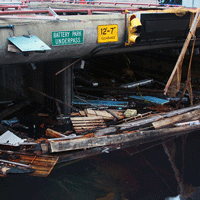
Climate Change Here and Now
View the page for this story
The Intergovernmental Panel on Climate Change is meeting in Japan to release its latest report, on the impact of climate change on society and the planet. Penn State professor Michael Mann and host Steve Curwood discuss how the report anticipates that increased conflict and declining supplies of food and water lie ahead. (06:50)
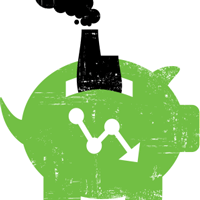
Exxon Agrees to Reveal Climate Change Risks
View the page for this story
Activist investors in major fossil fuel companies have been filing shareholder resolutions that ask the corporations to disclose their plans to address global warming, and the potential carbon regulation that could be coming. Danielle Fugere, President of the shareholder advocacy group As You Sow, tells host Steve Curwood that Exxon Mobil has agreed. (06:40)
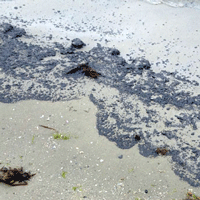
Oil Spills Increasing
View the page for this story
The 25th anniversary of the Exxon Valdez spill was marked by a tanker spill in the Gulf of Mexico, an oil pipeline rupture in an Ohio nature reserve and a BP refinery leaking oil into Lake Michigan. Lorne Stockman of Oil Change International tells host Steve Curwood that with the oil production boom in North America has come with an increase in spills. (07:00)

BP Set To Expand Oil Drilling in The Gulf
View the page for this story
New Orleans Times Picayune writer Jennifer Larino talks with host Steve Curwood about the recent EPA decision to allow BP to bid for federal contracts and expand drilling for oil in the Gulf of Mexico. (05:50)

Microbes, Dispersants, and Oil in the Gulf
/ David LevinView the page for this story
Four years after the Deepwater Horizon oil disaster, scientists are still studying the effect of dispersants on bacteria that help eat up hydrocarbons. David Levin reports. (06:30)
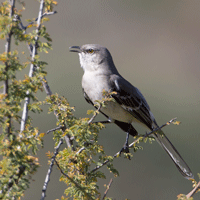
BirdNote®: Mockingbird
/ Michael SteinView the page for this story
Out in the garden, the cardinal is loudly telling the world who owns this territory. But another distinctive songster is also singing fit to beat the band and as Michael Stein reports in today's Birdnote®, the mockingbird can sound just like the cardinal. (02:05)

Beyond the Headlines
/ Peter DykstraView the page for this story
In this week’s trip beyond the headlines, Peter Dykstra tells host Steve Curwood three stories that sound like April Fool's jokes, but are 100% true. (03:45)
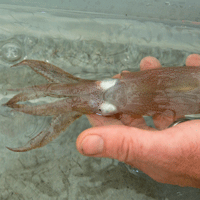
Sounds of the Sea
/ Jennifer JerrettView the page for this story
The ocean is a noisy place and human activity is making it worse. Jennifer Jerrett reports that biologists studying the role sound plays in the sea are making surprising discoveries among some squishy marine life forms. (08:00)
Show Credits and Funders
Show Transcript
HOST: Steve Curwood
GUESTS: Michael Mann, Danielle Fugere, Lorne Stockman, Jennifer Larino
REPORTERS: David Levin, Peter Dykstra, Michael Stein, Jennifer Jerrett
[THEME]
CURWOOD: From Public Radio International, this is Living on Earth. I’m Steve Curwood.
[THEME]
CURWOOD: The latest scientific analysis from the UN climate panel lays out what we can expect as the planet continues to heat up, and it's not a comforting picture.
MANN: This report, more than any other, really recognizes that climate change is happening now. It is negatively impacting our economy, our health, our access to food, to fresh water, and it’s leading to increased conflict.
CURWOOD: Also, 25 years after the tanker Exxon Valdez went aground, oil spills are on the increase.
STOCKMAN: We're seeing an oil and gas boom going on in North America generally, and together with that rise in oil production we are seeing a rise in spills. Last year in 2013 we saw about 120,000 barrels of oil spilled in the US from pipelines.
CURWOOD: That and more this week on Living on Earth. Stick around.
[NEWSBREAK MUSIC: Boards Of Canada “Zoetrope” from “In A Beautiful Place Out In The Country” (Warp Records 2000)]
ANNOUNCER: Funding for Living on Earth comes from Stonyfield Farm, makers of organic yogurt, smoothies and more.
Climate Change Here and Now

Flooding in Lower Manhattan after super storm Sandy, 2012 (Photo: NorthAtlanticDivision Flickr Creative Commons 2.0)
CURWOOD: From PRI and the Jennifer and Ted Stanley Studios in Boston, this is Living on Earth. I’m Steve Curwood. Some 2,000 scientists from around the world help craft the periodic assessments of the Intergovernmental Panel on Climate Change. The reports have three sections: the first projects the rate of warming, the second forecasts the impact of the warming, and the final one looks at solutions to the emerging climate crisis. The first part of this latest and fifth assessment was released last fall, and it warned that humans are creating a much hotter world. Now the draft of second part is done, and it paints a grim picture of how climate disruption will affect nature and civilization. For some analysis, we turn to Michael Mann. He's a distinguished professor at Penn State University and author of “The Hockey Stick and the Climate Wars”. Welcome back to Living on Earth.
MANN: Thanks. It’s great to be with you.
CURWOOD: So this is the second part now of the current IPCC report dealing with the impacts of climate change. Take us through some of the highlights.
MANN: Sure. What this report tells us is sort of what we already knew, but it’s more affirmative than the previous report. Climate change, we can now say with confidence, is impacting us everywhere, and what the report shows is if we continue with fossil fuel burning, business as usual, we will see far greater and far more detrimental impacts in the future as far as the impact on human health, on food, agriculture, on fresh water availability. Climate change is already a threat to national security. There’s increased conflict, and we will see far more damaging impacts if we continue going down this road.
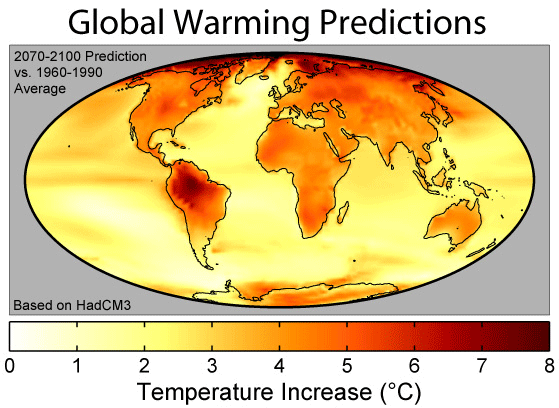
At the rate we’re going, certain parts of the planet will become so hot they will be unlivable. (Photo: Robert A. Rohde, Wikimedia Creative Commons)
CURWOOD: Now, let’s talk about some of the particular impacts that were mentioned in this report. What about the link between violence and climate change? What can you tell us about that?
MANN: Well, we know, I mean, history tells us, that there’s a very strong linkage between competition for resources and conflict. That has always been true, for example, in the Middle East where there’s relatively little fresh water, and many researchers have argued the conflict that we see in the Middle East fundamentally relates to the battle for fresh water resources in that region, while climate change is going to worsen the fresh water problem. We will see prolonged and more intense droughts in most of the major continents, which is a threat to agriculture, to food, to human habitation. We are going to see increased competition from a growing global population competing for diminishing resources. That is, essentially, a perfect storm for intense conflict and threats to national security.
CURWOOD: This affects the whole planet. How do folks in the US come out?
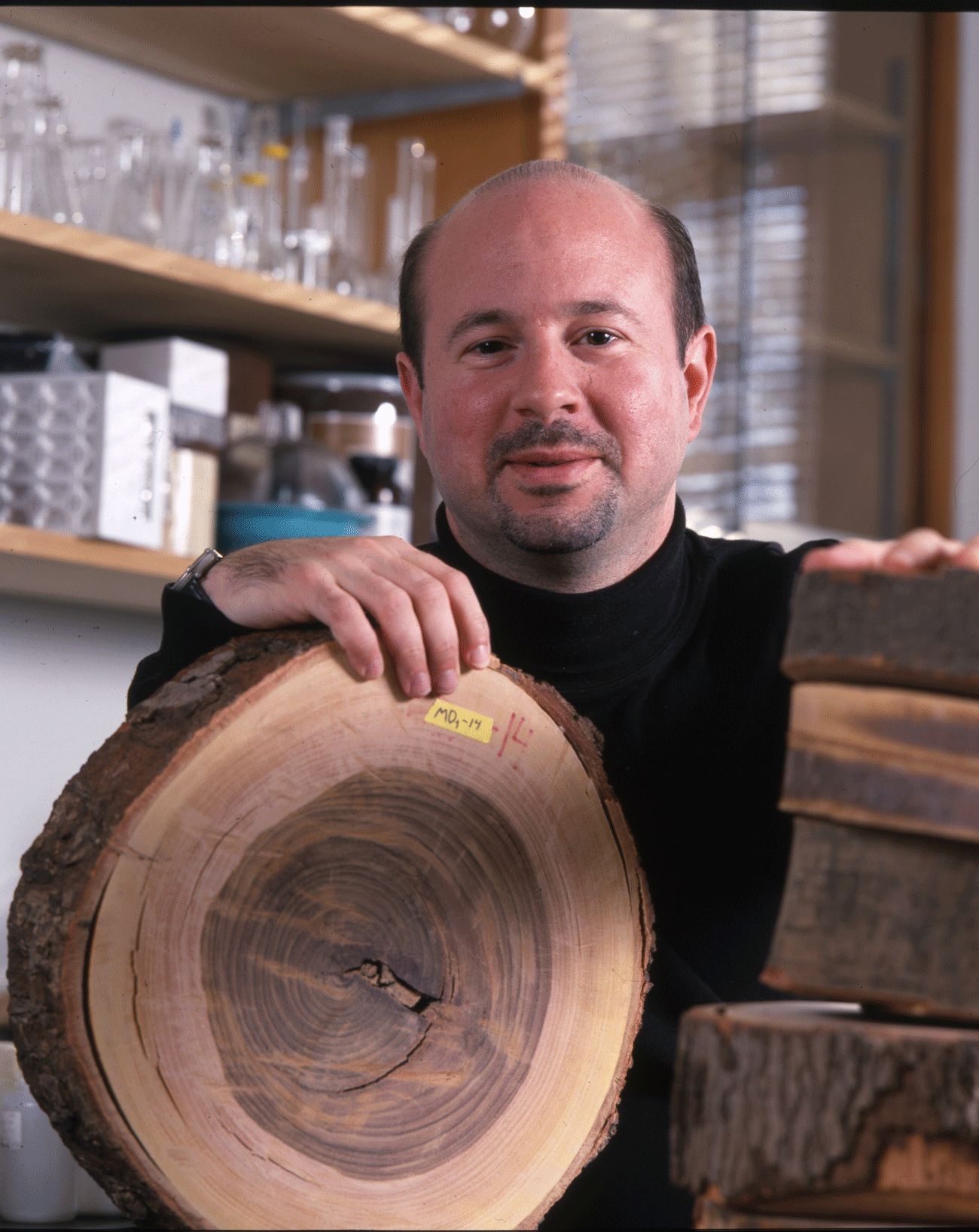
Climatologist and professor Michael Mann (Photo: Michael Mann)
MANN: Like folks in every other continent, it’s already clear that the impacts are damaging with respect to food, water and our economy. Hurricane Sandy, or Superstorm Sandy, cost us more than 65 billion dollars in losses here in the US. That’s a huge toll on our economy. And while we can’t say that Hurricane Sandy was literally caused by climate change, we know with some degree of confidence, that the impacts where made worse by climate change. For example, that 13-foot surge that flooded a large part of Manhattan, at least one of those 13 feet was due to human caused global warming. And so whether you look at impacts on extreme weather events, on drought, on the conditions that give us increased wildfire, we are already seeing climate change take a great toll on our economy here in the U.S., and it will only get worse.
CURWOOD: Where’s the worst place going to be in the world based on this current report? Who gets it the worst in terms of impacts?

Logo for the Intergovernmental Panel on Climate Change (Photo: Wikipedia)
MANN: It’s always difficult to say because there’s some level of uncertainty, but the fact is that in some regions, like the tropics, we will almost certainly see the worst impacts when it comes to issues like agriculture, for some very basic reasons. We know that even a little bit of warming in tropical regions leads to a very sharp decrease in agricultural productivity. We’ve seen that in recent years where extreme weather events have impacted food production and that has had negative repercussions for the global economy. We saw food prices spike due to extreme weather which we know, at least in part, is being impacted by climate change.
CURWOOD: What does the IPCC say about the impact on public health?
MANN: Well, public health, unfortunately, is one of those sectors where we may see some of the most profoundly negative impacts. There’s reason to believe that many extratropical regions that are currently immune to the effects of malaria because of killing frosts, cold winters...as those winters warm, as we see less of those killing frosts, we will see tropical diseases spread to higher latitudes; coastal flooding and extreme weather events create large amounts of standing water that is a health risk as well. One of the things that the report notes is that if we see seven degrees Fahrenheit warming of the planet, which is within range of the projections if we continue with business as usual fossil fuel burning, then many regions of the globe will literally be unlivable.
CURWOOD: So why might the public pay more attention to this report than others?
MANN: I think all too often we’ve allowed the picture of the polar bear stranded on a piece of ice up in the Arctic to be the poster child of human caused climate change and global warming. That has wrongly conveyed to the public that climate change is an exotic issue. I think what this report does effectively is to convey the fact that climate change is occurring now, it’s impacting us negatively where we live. So it’s actually somewhat remarkable to see a document like this, that by its nature is so conservative because it has to represent what a large number of scientists are all willing to commit to, actually state their findings in really such stark terms. When you read the description of the potential future impacts of climate change, you could be forgiven for mistaking this report for a post-apocalyptic plot that Hollywood had written about it.
The good news is that there is still time to act on this problem, and we have a critical decision to make. Are we going to mortgage the planet that we leave behind for our children or grandchildren, or are we going to take the actions that we need to now, so that decades from now we can look back and we can explain to our children and grandchildren that we saw the threat coming and we did act in time to avert catastrophe.
CURWOOD: Michael Mann is a distinguished professor at Penn State University. Thank you so much for taking the time today, Michael.
MANN: Thank you. It was a pleasure talking with you.
Related links:
- IPCC Web page
- Michael Mann’s The Hockey Stick and the Climate Wars
- Michael Mann home page
Exxon Agrees to Reveal Climate Change Risks
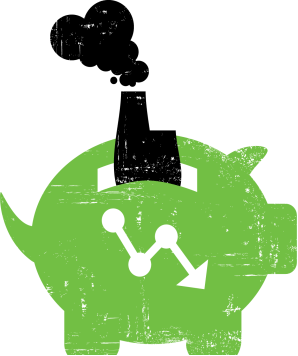
Image: As You Sow
CURWOOD: As the climate crisis becomes more apparent, shareholders are pushing fossil fuel corporations to say what impact global warming will have on company value, and now the two largest energy companies in America have responded. Coal giant Peabody Energy has told the Connecticut State Pension fund it will soon disclose its plans to deal with climate risk, and Wall Street is already discounting coal.
FUGERE: We just did an analysis off the cuff, but we looked at US coal mining companies and the majority of them, they’ve lost 65 to 75 percent of their value.
CURWOOD: That’s Danielle Fugere, the President of the shareholder advocacy group As You Sow. She says Exxon Mobil has just agreed to report how it plans to operate in a carbon-constrained world. In exchange, As You Sow and others withdrew a shareholder petition. Danielle Fugere says it's part of a growing trend.
FUGERE: I think in some sense, the fact that companies are going to have to report on these issues is inevitable. This year there’s been a shareholder engagement on these very issues, and $3 trillion worth of investment capital - so pension funds and other shareholders worth $3 trillion - have asked companies to begin reporting on these issues. So as the energy markets are beginning to change, there are starting to be financial concerns about the value of these companies, shareholders are getting a little bit nervous, and shareholders want to know what companies are going to be able to withstand these changes, what companies are preparing for a climate-constrained future.
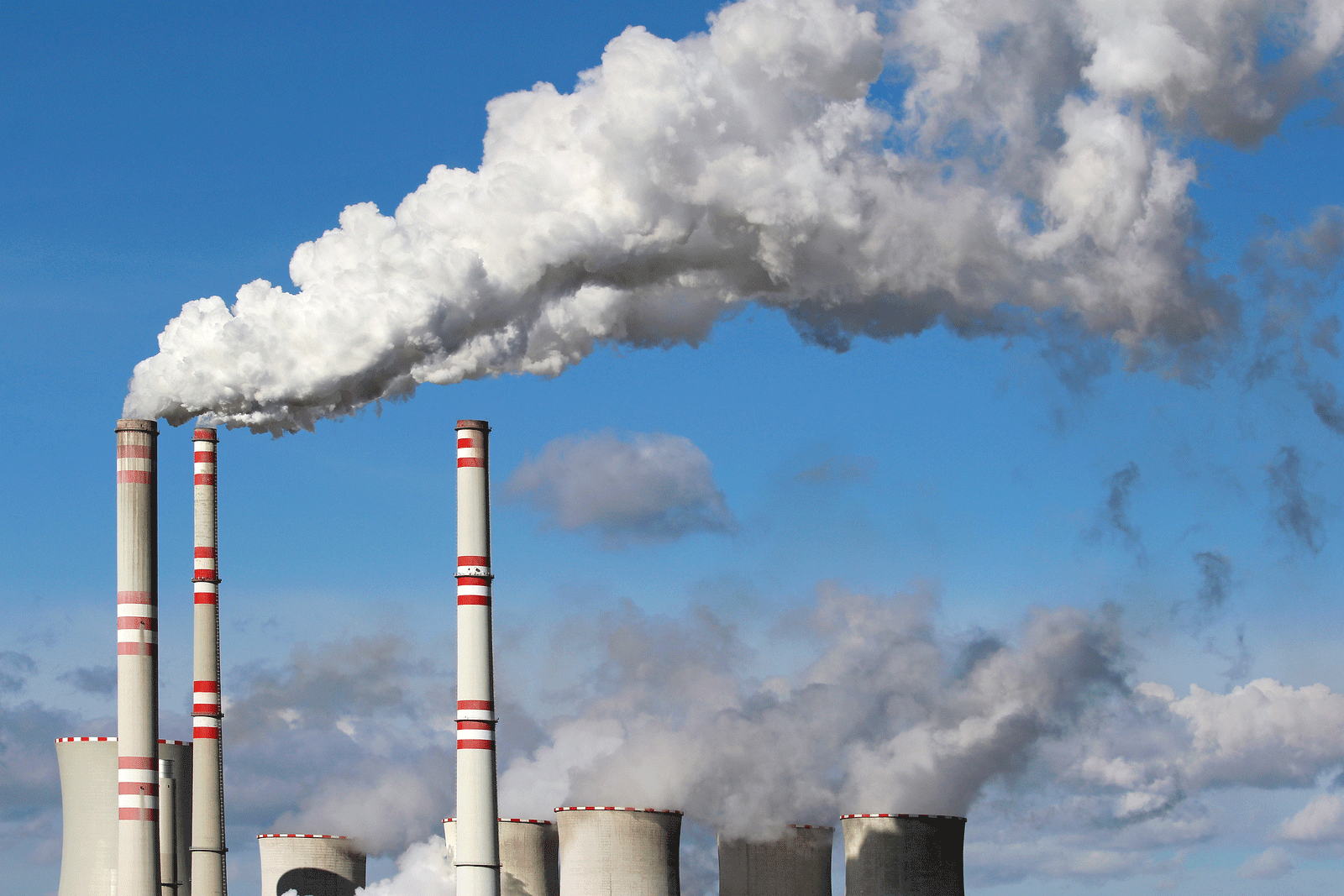
Coal companies will have a particularly hard time adapting to carbon regulations because coal is more carbon intensive then most fossil fuel sources (photo: bigstockphoto.com)
CURWOOD: Now, what exactly has Exxon agreed to disclose?
FUGERE: They have agreed to provide us information on how they assess the risk of a low-carbon scenario other than placing a price on carbon which they do now, but we don’t think that price is reflective of how constrained the companies might actually be, if the world responded to a two degree limit. They’ve agreed to assess the viability of their assets under 80 percent by 2050 reduction of greenhouse gas emissions, whether they’re tracking with IPCC. So some of these worst-case scenarios are they looking at those, and how is the company going to perform under those type of conditions.
CURWOOD: This is the Intergovernmental Panel on Climate Change, the science reports on this.
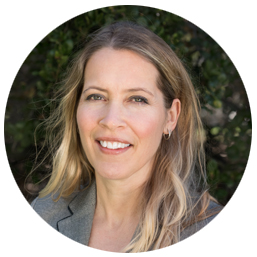
Danielle Fugere, President of As You Sow (photo: As You Sow)
FUGERE: Correct.
CURWOOD: Now Exxon has significant investments in natural gas. To what extent will they be able to claim that natural gas is a solution to their carbon problems, given the lower-carbon density in gas compared to oil?
FUGERE: Well, we are seeing that companies are thinking about moving to natural gas. A coal company that we brought the first carbon-asset resolution against or carbon bubble resolution, Consol Energy, which primarily was a coal company, they actually have sold off 50 percent of their coalmines and are now pursuing natural gas. Now, I think there are still questions about natural gas. It does burn at a lower-carbon intensity, but the question is how much leaking from the system occurs from production all the way to use, and if these systems are particularly leaky, if three percent of the gas is leaking, that means that natural gas may be worse than coal. So companies feel that natural gas is the way to go, but the question still remains whether that is the case, or whether we just need to get off fossil fuels entirely.
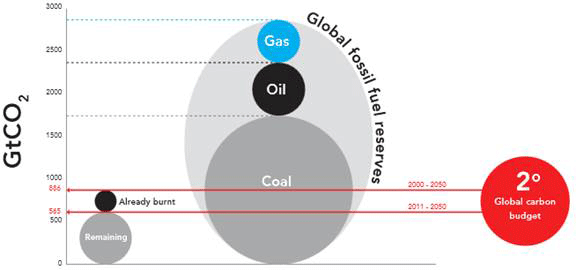
Carbon Bubble – Are the World’s Financial Markets Carrying a Carbon Bubble (image: Carbon Tracker Initiative)
CURWOOD: You filed another shareholder resolution regarding Exxon’s use of natural gas fracking. Tell us about that.
FUGERE: Well, what we have been doing is asking natural gas companies to provide quantitative information about whether they’re using best management practices because many of these companies, Exxon is one, that says, “We’re doing great. We are very protective. And don’t worry.” But we’re finding that’s insufficient to assure shareholders that that company can remain in business or even, as we see more and more moratoriums be put in place, be allowed into certain areas to get the natural gas out. So we’ve asked them to report on water management, what kinds of water are they using, are they recycling, are they putting their waste in open pits which can spill or are they putting them in tanks, what are they doing in terms of air quality, and a variety of those kinds of issues.
CURWOOD: And how has Exxon responded to that shareholder resolution?
FUGERE: Well, we believe we will be able to withdraw on that resolution as well, which would be a huge success because we’ve been talking with Exxon for five years. This is our fifth year, and so to finally have them be willing to provide additional disclosures on these issues is really important.
CURWOOD: What’s changed at Exxon? We carried remarks not long ago about the CEO getting upset about fracking in his own neighborhood where he lives in Texas. Folks at the top had a change of heart?
FUGERE: Well, maybe it’s hard to complain about fracking in your neighborhood and to not expect other people to have the same concerns. So, you know, I can’t say what’s in their minds, but all we can say is that this new proactiveness, and this willingness to engage meaningfully with shareholders is very welcome.
CURWOOD: Overall, what role do you think shareholders can play in the effort to curb climate disruption?
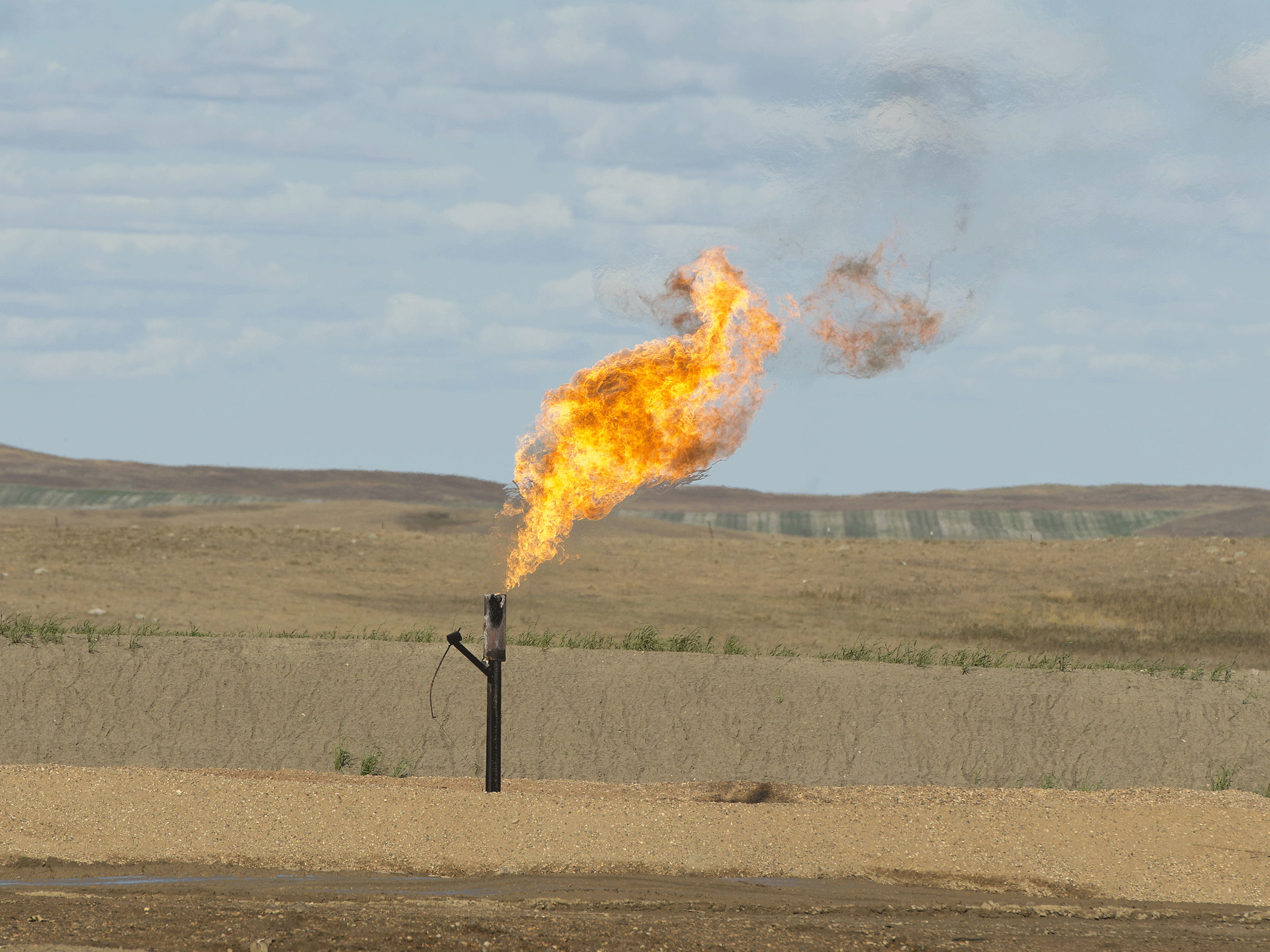
Many companies are embracing natural gas as a cleaner fossil fuel, but methane leaks could offset some of the benefits of natural gas (photo: bigstockphoto.com)
FUGERE: Well, this is an important role. I think for a long time one was able to assume that fossil fuel companies were a good investment. Times are changing, energy markets are changing, demand for these fuels is changing, and the cost of these fuels is changing. And shareholders are bringing this to the attention of the world and to policymakers, in fact. What we are also trying to avoid is the scenario of a carbon bubble where you have a lot of overvalued fossil fuel companies, and all at once the market recognizes that and the market bubble bursts and a lot of people have lost their investments. And so what we believe should be happening is money should be moving out of fossil fuel and into alternative resources, and that’s not to say that these fossil fuel companies cannot diversify. They need to start paying attention and figuring out how they will be in business in 10, 20 years, and that very likely is going to require diversification of assets moving into cleaner sources of energy.
CURWOOD: Danielle Fugere is the President of As You Sow in Oakland, California. Thanks so much for taking the time today, Daniel.
FUGERE: Thank you.
CURWOOD: We asked Exxon Mobil for comment, but they didn't get back to us by our deadline.
Related links:
- As You Sow
- Read the Exxon Mobil shareholder resolution
[MUSIC: Michael Bloomfield “Alberts Shuffle” from From His Head to His Heart to His Hands (Columbia Legacy 2014)]
CURWOOD: Coming up...how the tiniest creatures in the Gulf clean up the oil, and how our clean-up methods frustrate them. Keep listening to Living on Earth.
[CUTAWAY MUSIC: James Moody: “Country City Country” from The World Is A Ghetto (Fuel 2006)]
Oil Spills Increasing

Clumps of oil mar the beach on Galveston Bay after an oil tanker collided with another ship and spilled 168,000 gallons of oil into the water. It’s the largest oil spill in the Gulf of Mexico since the BP Deep Water Horizon accident 4 years ago. (U.S. Fish and Wildlife Service)
CURWOOD: It's Living on Earth, I'm Steve Curwood. Exactly 25 years to the day after the Exxon Valdez ran aground in Prince William Sound, Alaska, an oil barge off the Texas coast was hit by a ship and spilled as much as 168,000 gallons of bunker fuel into Galveston Bay. It’s the largest Gulf oil spill since the BP Deepwater horizon accident nearly four years ago. In the same week an oil pipeline leaked into a nature reserve in Ohio and a BP refinery spilled hundreds of gallons of crude into Lake Michigan. These days oil spills are increasingly common, according to Oil Change International. Lorne Stockman is their research director. Welcome to Living on Earth.
STOCKMAN: Hi. Great to be here.
CURWOOD: In brief, what are the dangers of oil spills? Why should people be so concerned about this?
STOCKMAN: Well, oil is an extremely toxic substance. It’s full of compounds which can make you very sick. It’s full of compounds that will kill plant life and kill wildlife. It’s very difficult to clean up. As we’ve seen with the Exxon Valdez spill 25 years on, the oil is still not gone from Prince William Sound, and we have not seen the herring fisheries recover, we haven’t seen the killer whales recover. So it’s an extremely persistent pollutant in the environment. It’s difficult to clean, and it’s highly toxic.
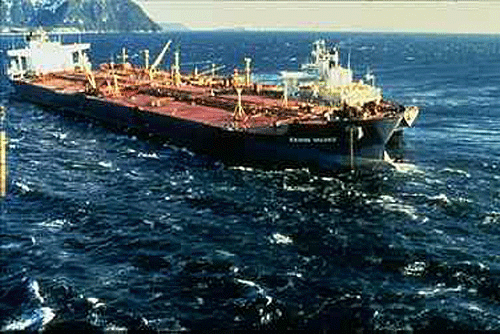
The Exxon Valdez oil tanker. (NOAA)
CURWOOD: So, tell me about the trend in oil spills in the US and internationally.
STOCKMAN: We’re seeing an oil and gas boom going on in the US and in Canada, in North America generally, and together with that rise in oil production - which is happening at breakneck speed at the moment across the country - we are seeing a rise in spills. Last year in 2013, we saw about 120,000 barrels of oil spilled in the US from pipelines.
CURWOOD: Barrels. And each barrel is, what, 42 gallons of oil.
STOCKMAN: 42 US gallons, that’s right.
CURWOOD: So we’re talking about millions of barrels of oil.
STOCKMAN: Absolutely. But it’s not just pipelines. We’re seeing oil being transported on trains. There’s been a tenfold increase in the number of spills from trains carrying crude oil since 2008. We’ve seen a number of spills on the Mississippi River where oil is being increasingly barged from rail terminals further north to Gulf Coast refineries. We see it coming from trucks, and we’re seeing it out on drilling platforms, so they’re happening just about everywhere where oil is either being drilled or transported right now.
CURWOOD: Let’s talk a bit about the pipeline infrastructure here in the United States. How old is this system? For example, what was the condition of the Ohio pipeline that spilled recently?
STOCKMAN: Well, the Ohio pipeline is called the Mid-Valley pipeline. It’s 52-years-old. So you know, a lot of the crude oil pipelines around the country were built in the 50s and 60s when US oil production was last booming. They’re aging infrastructure to begin with, but they also weren’t designed to carry the kind of oil that they’re carrying today. In particular, we’re seeing more of the Canadian heavy oil, the oil that comes from the tar sands in Alberta. It’s basically thicker, it’s more like a kind of tar than a liquid crude oil, and it’s not clear that these pipelines can handle the increases in pressure that increasing the capacity involves.
CURWOOD: Pushing the aging pipeline system isn’t enough obviously because, as you point out, we’re transporting more oil than ever by rail. Tell more about that.
STOCKMAN: Well, we’re seeing oil production coming up in places where we’ve never seen it before at these kinds of quantities, particularly in North Dakota. North Dakota’s really the center of the current oil boom, and also at the center of this trend of transporting oil by rail. Building pipelines is a costly business. It takes a lot of time. There’s a lot of permitting involved, and the oil producers, they don’t want to wait around for this infrastructure to be put in place. They want to get the stuff out of the ground as quickly as possible. So around the end of 2009, they began to look to trains to get the oil out of North Dakota, and that has spread around the country to other places where the oil boom is happening, whether it’s Ohio or Wyoming, Colorado or West Texas, they can basically, through the rail network, send their oil to anywhere in the country where there’s demand for it.
CURWOOD: Now as I understand it, before this huge explosion in the Lac-Mégantic in Quebec, that there weren’t any rules in Canada for transporting oil on trains.
STOCKMAN: There weren’t any specific rules in either Canada or the United States, and that train came from North Dakota, and traveled through the United States, traveled through Chicago, and there weren’t the sort of regulations in place that were needed to make sure that train was safe. And that’s really characteristic of the oil boom, that the regulators are often several steps behind what’s going on in the industry, and we don’t see a discussion of safety and regulations that we need until after some kind of disaster has happened.
CURWOOD: I just want to be clear that what you’re telling me is the train that crashed and burned very vigorously in Lac-Mégantic, Quebec, passed through the city of Chicago? That could have happened there?
STOCKMAN: Yes, and there are trains carrying the same crude oil that are passing through Chicago every day. There are well over 100 trains carrying crude oil through America’s communities and Canada’s communities at any given time.
CURWOOD: So oil spills are obviously a problem here in the US. How’s the rest of the world doing?
STOCKMAN: We have seen an uptick in the number of big spills, particularly on offshore oilrigs because we’re basically going further and deeper for our oil production as we use up this sort of low-hanging fruit. So we’re seeing particularly off-shore, off West Africa and Brazil, we’re seeing companies drill ever deeper, and with that comes higher risks, more complicated logistics, higher pressures underwater.
The other place where we see a tremendous amount of spillage is in Russia where it’s estimated there’s some 30 million barrels of oil spilled every year. So that’s about seven times the amount that escaped from the Deepwater Horizon disaster in the Gulf of Mexico mainly onshore from pipelines crisscrossing Russia. Most of these are spilling into the rivers that lead to the Arctic Ocean in Russia. So we’re seeing a tremendous amount of oil spilled into the Arctic environment from onshore oil production in Russia.
CURWOOD: What do you think should be done to reduce oil spills here in the US and around the world?
STOCKMAN: I think we need to enforce regulations and penalize the companies much harder, and unfortunately we’re just not doing that, not in America nor elsewhere.
CURWOOD: Lorne Stockman is the Research Director at Oil Change International. Thanks so much for taking the time with us today, Lorne.
STOCKMAN: You’re welcome, thank you.
[MUSIC: Daft Punk “Giorgio By Moroder” from Random Access Memories (Columbia Records 2013)]
BP Set To Expand Oil Drilling in The Gulf

BP’s logo. Rosenfeld Media, Flickr, Creative Commons 2.0
CURWOOD: 25 years later, there's still oil from the Exxon Valdez along the shores of Prince William Sound. And after nearly four years, science is still determining the full extent of damage from the massive blowout of BP’s Deepwater Horizon well in the Gulf of Mexico. And now, though BP has yet to be assessed penalties under the Clean Water Act, the Obama Administration has given the company the green light to expand its operations in the Gulf. Jennifer Larino, staff writer at the New Orleans Times Picayune, is on the line to talk about the impact of that decision and the status of the remaining litigation. Welcome to Living on Earth, Jennifer.
LARINO: Hi, thanks for having me.
CURWOOD: So what’s going on now with the EPA decision to allow BP to drill again?
LARINO: Well, basically, back in November 2012, the EPA had put a temporary ban on BP getting federal contracts in light of the criminal charges and eventual admission of BP related to the Deepwater Horizon rig explosion and the ensuing oil spill. So essentially, the EPA said for a temporary time, we’re not going to do business with you, and we cannot give you federal contracts. March 14th the two parties came to an agreement where BP will undergo regular audits of its internal operations, its safety procedures, all those sorts of things and will again be able to vie for federal contracts, whether that be selling oil and gas to the military or vying for bids offshore in the Gulf of Mexico to drill oil and gas there.
CURWOOD: What’s the perception about BP as a better company?
LARINO: Not just BP, but all companies working in the Gulf are going to be under a microscope, essentially. I will say that there are concerns of whether or not the federal government and the agencies overseeing drilling offshore have the manpower to really truly enforce some of these standards that they’re developing and these agreements that they’re meting out. That’s one concern I’ve heard voiced.
CURWOOD: How soon do you think we’ll see BP out drilling again?
LARINO: We’re already seeing it. They have ongoing projects. They’ve committed to spending $4 billion a year over the next decade. BP had ongoing projects before the BP oil spill, 2010 oil spill, so these platforms that are out there, they’re basically bringing the existing wells that they had, bringing them on line and starting oil production. These projects take several years to bring to fruition, so something that might have started before 2010 could just now be coming on line. So we’re seeing a couple of their projects that they had been working on come on line now. In terms of new drilling, that will take a couple more years. For BP, they were one of the largest providers of oil and gas to the US federal government so they definitely want to get in the business again, and that obviously has repercussions for our federal government and how they interact with them.
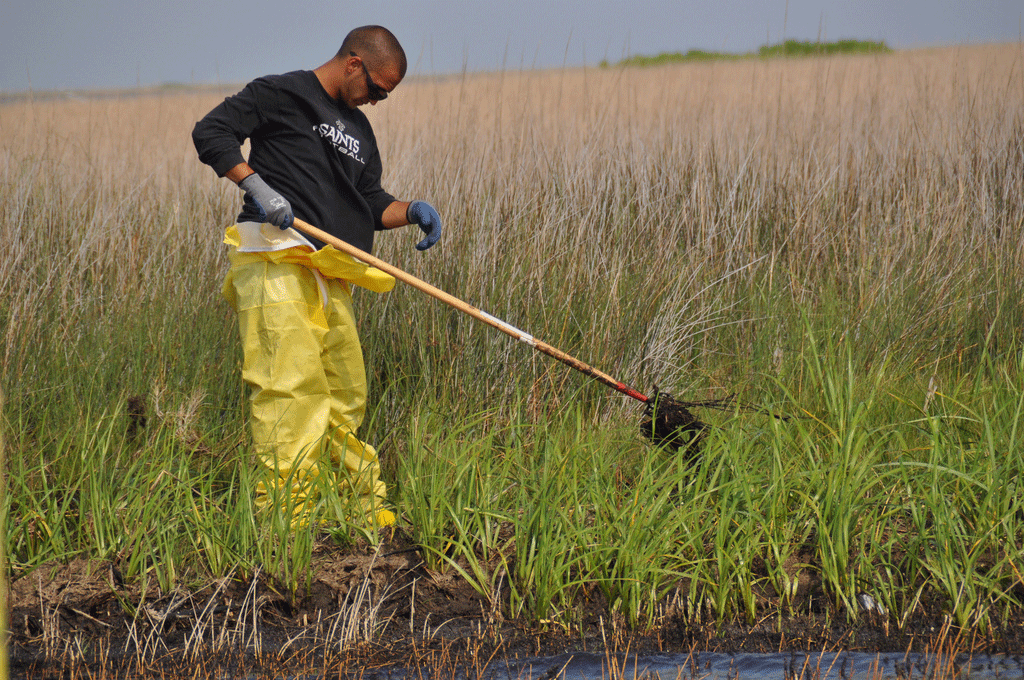
Raking a marsh during the BP oil spill clean up. Gulf Restoration Network, Flickr, Creative Commons 2.0
CURWOOD: Now how do people in Louisiana, in the Gulf Coast area...how do people feel about BP getting the green light to get back into doing federal contracts, possibly drilling again?
LARINO: Well, that’s a good question. There is a lot of different dynamics when you look at south Louisiana. Many families have people who work in the fishing industry, and also work in the oil patch. So, on the one hand, you do have a large environmental concern from environmental groups in south Louisiana that are looking at coastal erosion, looking at our fishing industries that depend on a clean Gulf, and have legitimate concerns, that not just BP, but everyone operating offshore is doing it safety and observing the rules that keep everything safe. On the other hand, a lot of our economy is tied to the oil and gas industry. A lot of people work offshore and as activity ramps up after the oil spill -- there was a real lull that hit a lot of business very hard -- so as things ramp up, a lot is entangled with that industry and there is support for getting major gas companies like BP back out to work, obviously under safe conditions, but allowing them the opportunity. So you see kind of mixed bag of emotions out here.
CURWOOD: How’s the court case against BP progressing -- or I should say court cases?
LARINO: Oh yes, [LAUGHS] They are embroiled in litigation on multiple fronts. There’s litigation that has to do with the actually spill itself and assigning blame essentially for how much oil was actually spilled, what sort of penalties should stem from that, what were the causes of the spill. A lot of people were in tune with that trial. It has three phases - it’s gone through two already - and it has a third. And the final phase will actually be the penalty phase.
There’s also litigation that has to do with the claims side of things. There was a settlement made in early 2012 that basically dealt with a lot of the seafood claims, a lot of the cleanup worker claims, in one fell swoop, but what we’re seeing now is BP kind of attacking that process moving into 2014 here. They had originally estimated that would cost them about $7.8 billion, now they’re saying that fraud potentially ballooning that estimate of what they’re going to spend, and through litigation trying to figure out a way that they can eliminate fraud, of what say see as fraud in the claim system. So, there’s litigation surrounding that as well.
CURWOOD: I want to thank you for taking this time with us today. Jennifer Larino is a staff writer at the New Orleans Times Picayune. Thanks so much, Jennifer.
LARINO: Thanks for having me.
Microbes, Dispersants, and Oil in the Gulf
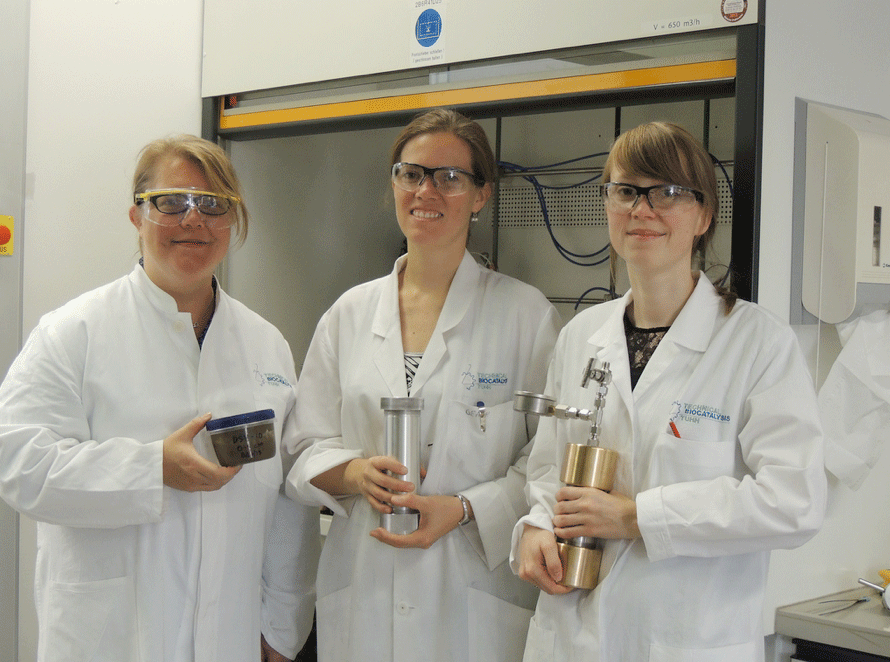
C-IMAGE post docs Sara Lincoln, Ana-Gabriela Valladares Juarez, and graduate student Martina Schedler hold sediment samples from the Gulf of Mexico and high-pressure chambers in the laboratory at the Technical University of Hamburg. (S. Gilbert)
CURWOOD: When the Deepwater Horizon disaster happened in April 2010, oil gushed into the ocean for nearly three months, and millions of gallons of dispersants were sprayed on the well head.
Some say the dispersants may have made the surface of the ocean look better but at the cost of increasing the toxicity of the spill. Scientific research on the effects of the dispersants is ongoing, and David Levin travelled to Hamburg Germany to check in on the work of scientists from the Center for Integrated Modeling and Analysis of the Gulf Ecosystem.
[FISH MARKET IN ALTONA]
LEVIN: It’s 7 a.m. in Hamburg, Germany, and the Altona fish market is packed with shoppers. Every Sunday, people crowd into the famous open air market, which stretches along the Elbe river. Shoppers haggle over mackerel, squid, shrimp, giant fillets of tuna.
Across town, in a lab full of humming equipment, a team of scientists is looking at their own catch of the day. But they’re not interested in fish. They’re focused on tinier things. Single-celled organisms like bacteria and small plants called algae.
In 2010, the Deepwater Horizon oil spill affected countless little organisms like these in the Gulf of Mexico. And cleanup efforts may have made things even worse for them—to get rid of the oil, crews sprayed huge amounts of toxic chemicals called dispersants into the water. And they had nasty side effects.
Tinka Murk is a researcher at Wageningen University in the Netherlands.
MURK: The unexpected problem we saw now is that it irritated the algae, and the algae produced a kind of protein that is sticky like a spider’s web.
LEVIN: It looked kind of like snot. It stuck to the oil, mixed with sediments in the water, and sank to the bottom.
MURK: So instead of diluting the oil, you are concentrating the oil on top of the sea floor.
LEVIN: That may not seem like a big deal. After all, oil that sinks to the bottom can’t get onto beaches and wetlands. But as it piles up on the ocean floor, it can kill off tiny creatures at the bottom of the food chain. And that has a big impact on other species, like commercial fish.
HOLLANDER: It’s a no-win situation. You have your choice of what part of the ecosystem do you want to impact the most.
LEVIN: David Hollander is a geochemist from the University of South Florida. He’s here in Hamburg to meet with researchers who study the spill.
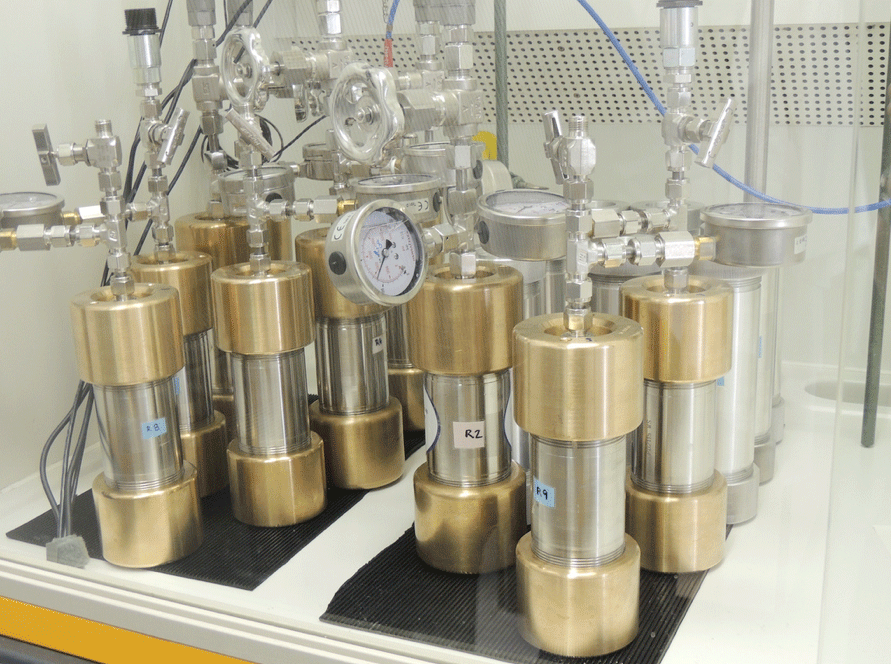
High-pressure reactors are constructed to monitor biodegradation under deep-sea conditions at pressures up to 150 bars. (S. Gilbert)
HOLLANDER: The technology for cleanup has lagged behind the technology for exploration significantly. Once the Deepwater Horizon spill happened, they were using large amounts of dispersants—essentially the identical technologies that were used in the 1970s, they were using in 2010 to clean up the oil.
LEVIN: So… how do you deal with that much oil? Well, it turns out, some tiny creatures in the Gulf already have a solution. They eat it.
MÜLLER: There are bacteria in our environment, and you find them everywhere, that can eat oil as food. And the more food they get, the better they grow.
LEVIN: This is Rudi Müller, a microbiologist at the Hamburg University of Technology. He says that after the Deepwater Horizon, species of bacteria that live on the sea floor had an all-you-can eat buffet. But exactly how much they ate, or how fast, is still kind of a mystery.
MÜLLER: There are indications that the bacteria grow down there on the oil. But the question there is, how do bacteria behave in the deep sea, under high-pressure, low temperature conditions?
LEVIN: To figure that out, Müller’s turning to custom-made equipment.
[WHIRRING FANS, LAB SOUND]
MÜLLER: So, here’s the pressure lab…
LEVIN: Under a plexiglass lab hood, Müller points to a half-dozen bronze cylinders. They don’t look like much—each one’s only about a foot tall. But inside them, he’ll mix bacteria and oil, then crank the pressure up to more than two thousands pounds per square inch to recreate conditions at the bottom of the Gulf. By studying what happens next, he can learn what the microbes actually do to oil in the deep ocean.
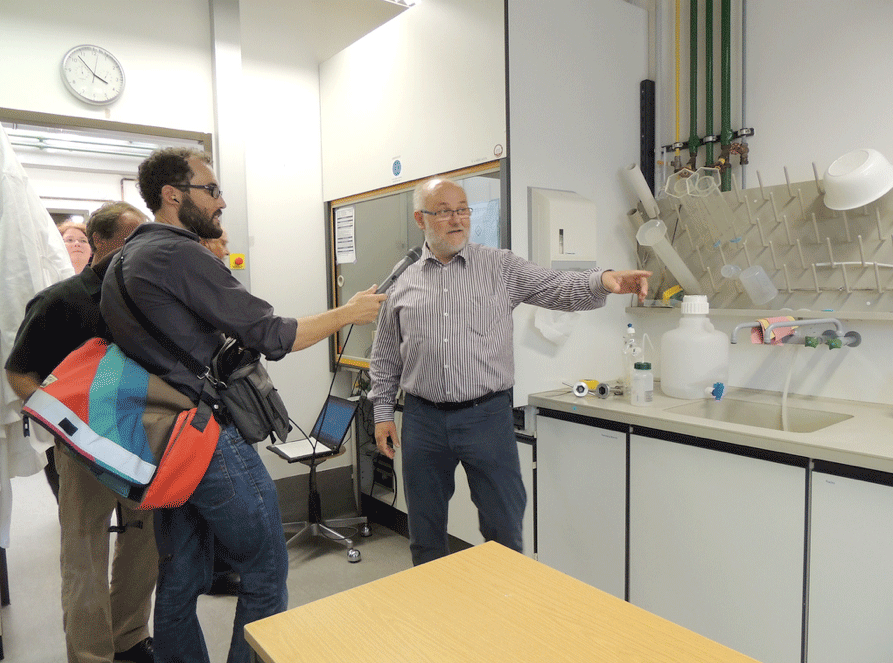
Professor Dr. Rudolf Müller, a microbiologist at the Hamburg University of Technology, talks to David Levin about organisms that live deep in the ocean and eat oil. (S. Gilbert)
Working with devices like these isn’t always easy, though.
[CLANKING SOUNDS]
Ana Gabriela Valladares Juárez is fighting with a mess of pipes and valves she’ll use to pressurize the cylinders. She’s a post-doc in Müller’s lab. In one hand, she holds a pair of pliers—in the other, a big wrench.
JUAREZ: So now, we can open the valve.
[HISSING SOUND FROM VALVES]
Oh! As you see, we have a leak…
LEVIN: Leaks like these aren’t uncommon. Valladares Juárez says it can take hours to get a solid connection. But once the experiments are up and running, she’ll be able to see how bacteria break down the oil, and what conditions make it possible.
[CLANKING SOUNDS]
This is not just an academic exercise. David Hollander says studying these bacteria might lead to a new way of cleaning up oil spills.
HOLLANDER: There’s new visions for different types of dispersants which not only involve the breakdown of oil into finer particles, but the application of microorganisms that are capable of degrading the oil, so that when the dispersants break it into small particles, the microorganisms can attack it.
LEVIN: In other words, it might be possible to harness bacteria that already love to eat oil, and use them to our advantage during a spill.
Again, Rudi Müller.
MÜLLER: There, it might be helpful, yes. As a starter to have a faster degradation in the first, say, few hours or the first day or so.
LEVIN: The idea is if you can put the right bacteria in the right place at the right time, you could break down the oil enough to get rid of its most poisonous ingredients – compounds like benzene and toluene.
MÜLLER: So there are a lot of compounds that you can degrade when you have the right bacteria. The question is can you do it reliably? Does it make sense? How much does it cost to do it?
LEVIN: To make this possible, Müller says you’d need a huge supply of oil-eating bacteria ready to go at all times, and you’d have to pump them onto the oil within a few hours of a spill. Scientists are still a long way from making that a reality. But if they did, it could make a big difference for first responders, who get exposed to those toxins during cleanup.
For now, though, Müller and his team are focused on learning as much as they can about the bacteria themselves. Like how they behave. How they actually use the oil, and what happens to them in the process. By understanding how these organisms work, the researchers might be able to tell what role the bacteria naturally play in the aftermath of an oil spill. And someday, that might even change the way we react to those disasters.
For Living on Earth, I'm David Levin in Hamburg, Germany.
[MUSIC: Don Byron “Charley’s Prelude” from Bug Music (Nonesuch Records 1996)]
CURWOOD: Coming up...listening in on squishy creatures in the ocean. That's just ahead on here Living on Earth. Stay tuned.
[CUTAWAY MUSIC: The Exodus Quartet: “Trance Jazz” from Way Out There (Instinct Records 1996)]
ANNOUNCER: Funding for Living on Earth comes from the Grantham Foundation for the protection of the environment, supporting strategic communications and collaboration in solving the world’s most pressing environmental problems. The Kendeda Fund, furthering the values that contribute to a healthy planet, and Gilman Ordway for coverage of conservation and environmental change. This is PRI, Public Radio International.
BirdNote®: Mockingbird
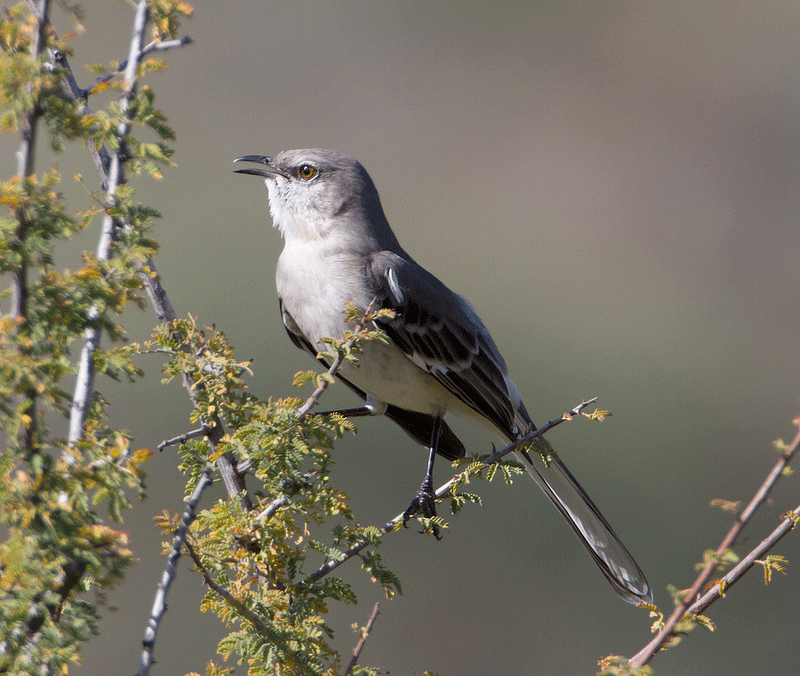
Northern Mockingbird (Laura Gooch)
CURWOOD: It's Living on Earth, I'm Steve Curwood.
BIRDNOTE®/MOCKING BIRD
[BIRD NOTE® THEME ]
CURWOOD: Those of us up in the northern part of North America are starting to think about getting out into our gardens - at last - but already the cardinals are singing loudly outside the windows. And as Michael Stein explains in today's BirdNote®, they're not alone.
The Mockingbird – A Virtuoso of Variety
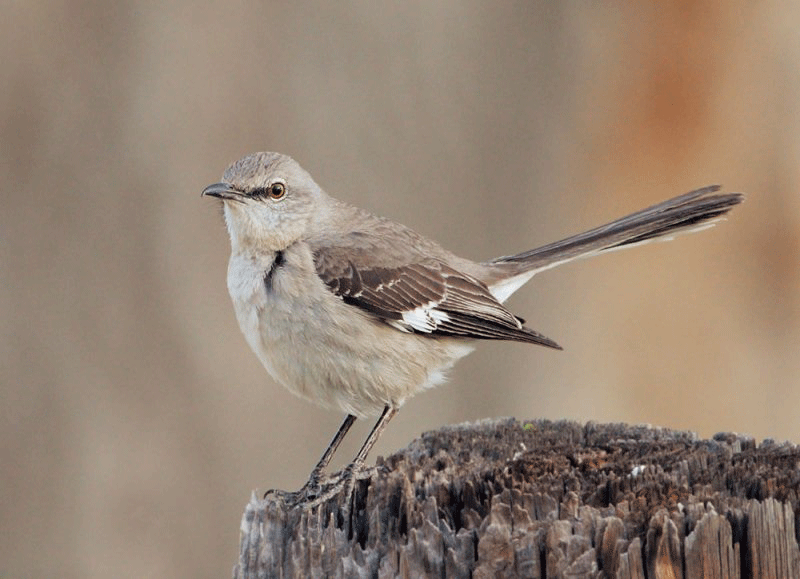
Northern Mockingbird Perched. (Tom Grey)
[NORTHERN MOCKINGBIRD SONG]
STEIN: Some birds have a lot to say. But few surpass the Northern Mockingbird.
[SONG OF NORTHERN MOCKINGBIRD]
Within its range in the US, which is most of the country except the northern West and Midwest, you’ll recognize the mockingbird’s song instantly.
[SONG OF NORTHERN MOCKINGBIRD]
A very distinctive song, but perhaps not a thing of beauty.
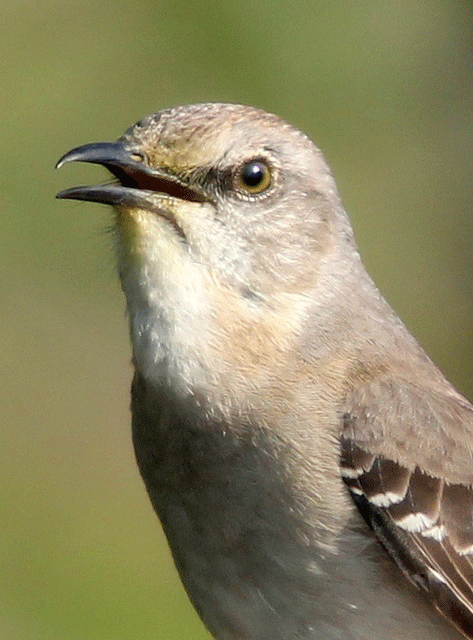
Northern Mockingbird (Kenneth Cole Schneider)
But while the mockingbird may not sing beautifully, it’s a virtuoso of variety, persistence, and mimicry. Mockingbirds sing all year – in the breeding season to attract mates, the rest of the year to claim feeding territories. In spring, a male mockingbird sings all day, hundreds of variations – then sings all through the night!
[MOCKINGBIRD]
The aptly named mockingbird is also an uncanny mimic. A mockingbird might imitate, in succession, birds as different as a bobwhite quail, a chat, a sandpiper – even a cardinal - then cap it off with meow of a cat and a few phrases of car alarm.
[SELECTION WITH MIMICS]
And he’s just getting warmed up. [MOCKINGBIRD]
[LONG RUN OF THE SONG OF THE NORTHERN MOCKINGBIRD]
###
http://birdnote.org/show/mockingbird-virtuoso-variety
Written by Bob Sundstrom
Bird sounds provided by The Macaulay Library of Natural Sounds (ML) at the Cornell Lab of Ornithology, Ithaca, New York. Songs of the Mockingbird [94375] and [94374] and [85197] recorded by W. Hershberger; and [118628] recorded by G.A. Keller.
Producer: John Kessler
Executive Producer: Chris Peterson
© 2014 Tune In to Nature.org March 2014 Narrator: Michael Stein
CURWOOD: For photos of the mockingbird looking like himself, not some other bird, hop on over to our website LOE.org.
Related link:
BirdNote ®
Beyond the Headlines

NASCAR claims to have a carbon-neutral race (photo: bigstockphoto.com)
CURWOOD: Well, the mockingbird sounds a particularly appropriate note for our trip beyond the headlines today with Peter Dykstra. He's the publisher of Daily Climate.org and Environmental Health News - EHN.org. - and joins us on the line from Conyers, Georgia. Hi there, Peter.
DYKSTRA: Hi Steve. You know, it’s a grand time of year for folks like me because April Fools’ Day is upon us, and one of the best parts of April Fools Day are those things that sound like hoaxes and pranks, but they turn out to be true. So remember, everything I’m about to tell you actually happened.
CURWOOD: Even if it sounds like it didn’t, huh?
DYKSTRA: Right. One of my favorites happened six years ago, when NASCAR went carbon neutral. Back in 2008, they designated one single Saturday race as contributing no net gain of carbon dioxide into the atmosphere because they paid a conservation group to plant 4,200 carbon-eating trees.
CURWOOD: And they said that offset the NASCAR race?
DYKSTRA: Not just the NASCAR race, but the 100,000 plus spectators who came to the race. All that, they said, can be neutralized by planting what amounts to six acres worth of forest. But there’s a little math problem here. The Michigan International Speedway, where this carbon neutral race occurred - if you take the grandstand, the track, the infield, the parking lot - it’s 1,100 acres of what at one time was a forest.
CURWOOD: Yes, you’re right about the math problem here. I’m trying to figure this out. Let’s see...one green race a year...six acres...so they could reforest an area the size of the racetrack in about 250 years.
DYKSTRA: Ah, close. It would actually be 233 years, so they’d be all done by the year 2247.

American Spirit sells Organic cigarettes (photo: Flickr user ATIS547, creative commons 2.0)
CURWOOD: Now, Peter, you’re not saying that carbon offsets are a bad thing, are you?
DYKSTRA: No, not at all. Carbon offsets, when they’re practiced regularly, when they’re practiced on a widespread basis, can be a major part of dealing with climate change, but you don’t get to claim credit for a bright green glow just by planting six acres’ worth of trees, once. Sometimes, embracing a term like “carbon neutral” or carbon offsets can be empty gestures that do more for your marketing department than it does to help your planet.
CURWOOD: What’s up next?
DYKSTRA: This one’s been around for about 20 years, but it never ceases to amazes me. The American Spirit Tobacco has a special marketing niche of its own – they sell organic tobacco that is free of pesticides.
CURWOOD: But it’s still tobacco…
DYKSTRA: It’s still tobacco, and not only does it carry the standard Surgeon General’s warning, but their website also has another warning that reads, “No additives in our tobacco does NOT mean a safer cigarette.”
CURWOOD: So you can still get cancer from pesticide-free cigarettes, but thank heavens it won’t be from the pesticides.
DYKSTRA: Yeah, it’s like saying, “Just shoot me. But please don’t use lead shot.”
CURWOOD: OK. What about one more?
DYKSTRA: Well this one’s also an oldie-but-goodie, it comes from 1990. It’s one of the first occasions when global governments got together to discuss and plan for climate change. One of the U.S. delegates was Julian R. Spradley, he was an attorney and lobbyist. Mr. Spradley got into a discussion with the Bangladeshi delegation, who had somehow gotten the impression that the United States wasn’t taking climate change seriously enough, so Mr. Spradley summoned up his best diplomatic instincts to calm the Bangladeshis’ fears about climate change. He said, as quoted by the Washington Post:
“The situation is not a disaster, it is merely a change. The area won't have disappeared, it will just be underwater. Where you now have cows, you will have fish.”
CURWOOD: Well, I’m sure he thought that was fine with the 150 million plus Bangladeshis. And Peter, you’re promising us that all these things really did happen?
DYKSTRA: Yes. As James Thurber said, you can look it up.
CURWOOD: Well, you can look all of this up on our website, that’s LOE.org. Peter Dykstra is publisher of the Environmental Health News and the DailyClimate.org. Thanks so much, Peter.
DYKSTRA: Thanks a lot, Steve. Talk to you soon.
Related links:
- The Daily Climate
- NASCAR goes Carbon Neutral
- American Spirit Tobacco
- Read the original story of Julian Spradley’s comments before the Bangladeshi climate delegation here
[MUSIC: Donald Fagan “Weather In My Head” from Sunken Condos (Reprise Records 2013)]
Sounds of the Sea
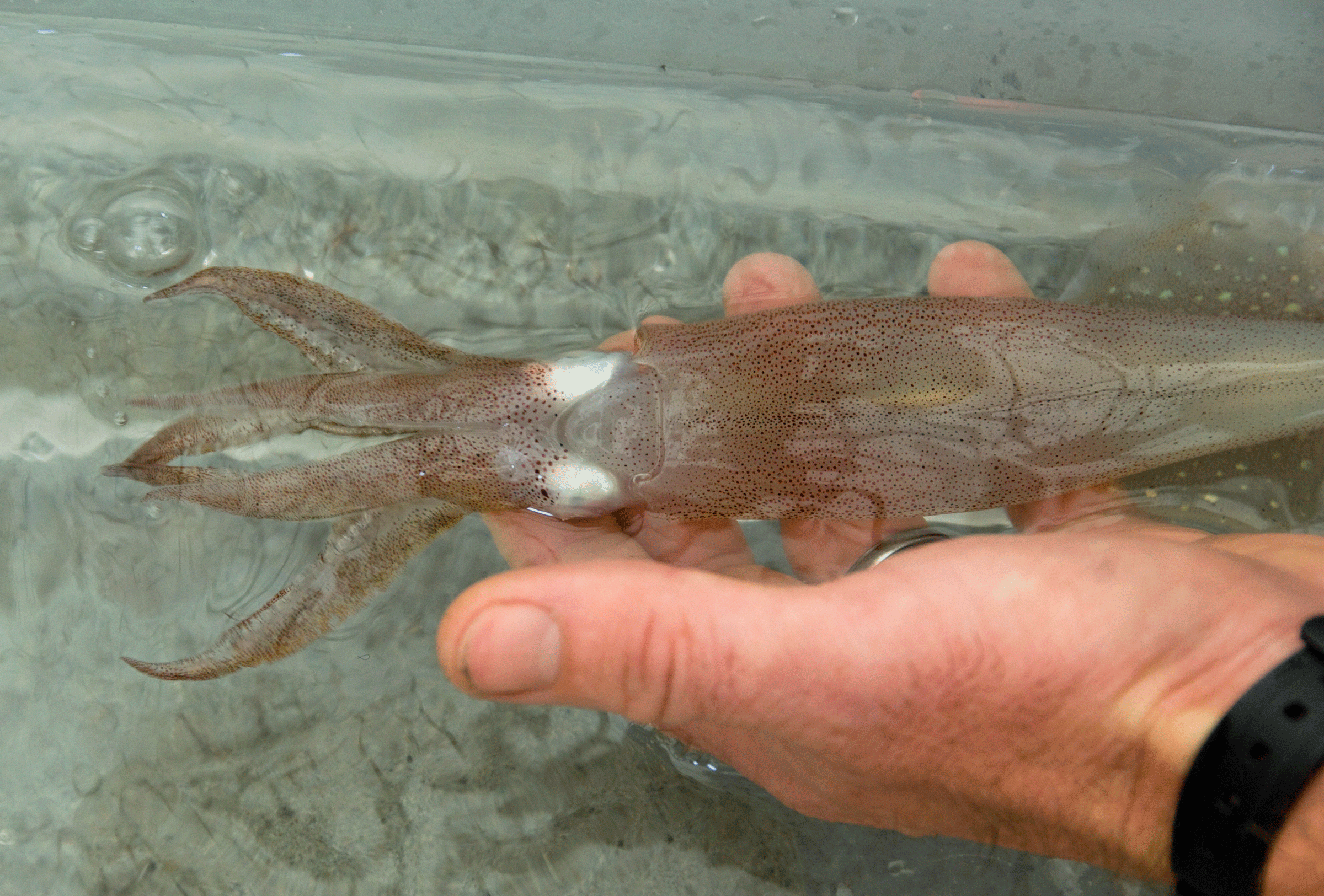
Aran Mooney working with squid in his lab (Photo: Woods Hole Oceanographic Institution)
CURWOOD: Oceans cover 70 percent of the planet, and though we've been traveling over them for millennia, and diving under them for over a century, they still hold many secrets. Among those mysteries are many of the strange creatures beneath the waves -- and marine biologists are getting a new understanding of the role that sound plays for some of them. And as the sounds we humans create in the seas increase, deepening that understanding becomes more urgent. Reporter Jennifer Jerrett visited the Woods Hole Oceanographic Institution, and has our report.
[SOUNDS OF D-TAG SIGNAL AND BOAT SPLASHING ON WAVES. MAX BERNARD OFF MIC: "SO ARAN, ARE YOU READY?"]
JERRETT: On the video I'm watching at the Woods Hole Oceanographic Institution, four scientists are clustered toward the front of a 27-foot Boston Whaler. One guy is hanging over the water off a skinny platform at the front of the boat. He's got an ankle wrapped around the rail to keep from falling in. He's very gingerly trying to attach an acoustic monitoring tag, or a "D-Tag" to a dolphin.
[SOUNDS OF PLACING THE TAG. PERSON ON THE BOAT SAYING “THERE YOU GO!"]
JERRETT: Aran Mooney is the team leader for this operation.
MOONEY: I really love working with, um, that dolphin or that squid. I really like kinda being able to work with and address an animal that I can see and hold and touch and look at.
JERRETT: Aran Mooney is a marine biologist at the Woods Hole Oceanographic Institution. He specializes in sensory ecology and bioacoustics. This means he studies the role that sound plays for animals in the ocean.
[SOUNDS OF DOLPHIN CLICKS]
JERRETT: The dolphins he studies are well-known sound specialists. They use sonar, or echolocation, to map their underwater world.
[MORE DOLPHIN CLICKS]
JERRETT: To put it in human terms, they basically ‘see’ with sound. And dolphins also use sound to communicate.
[ SPLASHING AND DOLPHIN CHIRPS, THEN LOW-FREQUENCY RUMBLING SOUND OF BLUE WHALE]
JERRETT This blue whale uses sound to communicate, too, and it's possible blue whales are calling to each other across entire oceans. Over hundreds, or even thousands of miles.
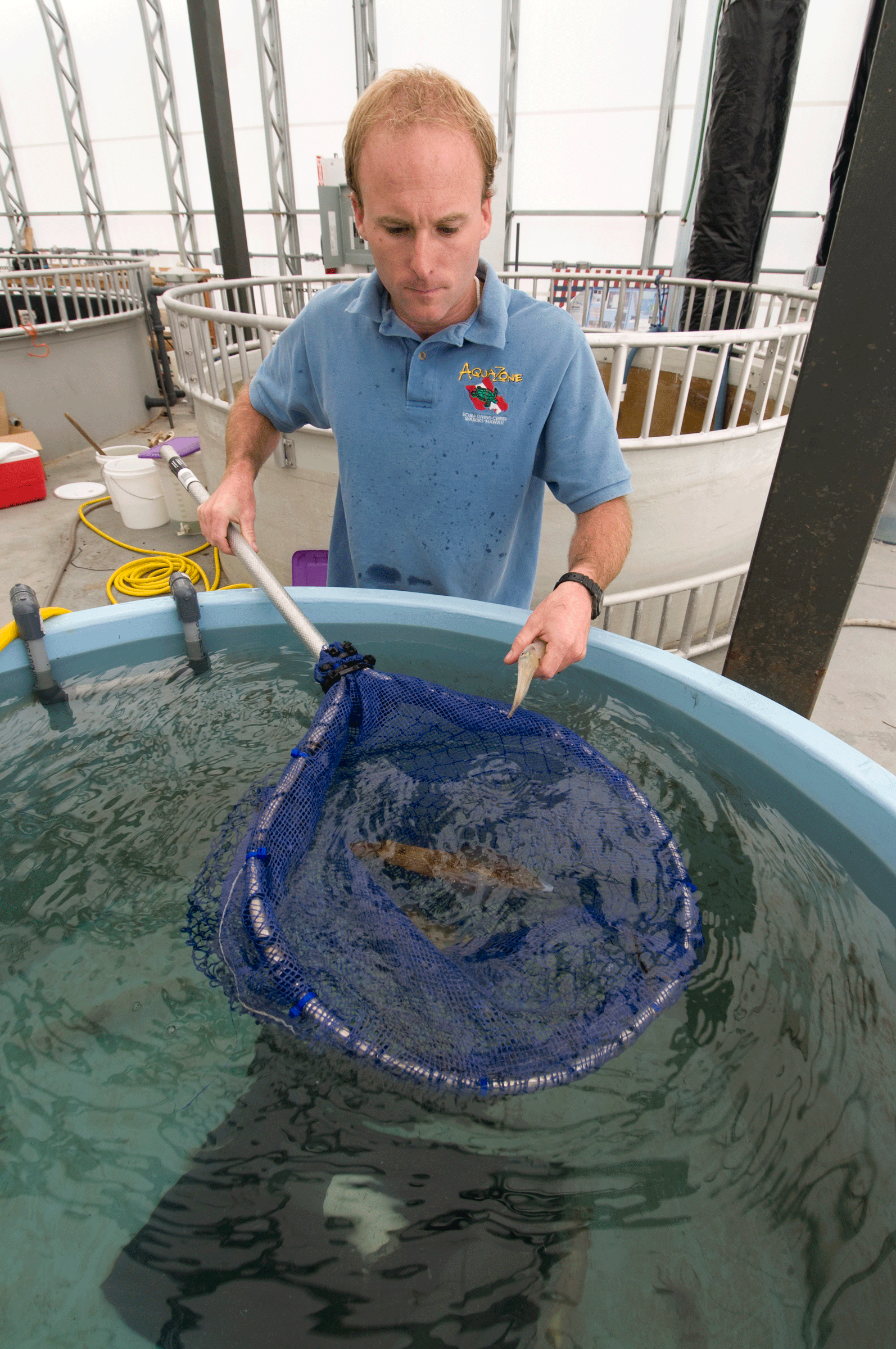
WHOI biologist Aran Mooney gently lifts a squid from a tank in the Environmental Systems Lab. (Photo: Woods Hole Oceanographic Institution)
JERRETT: Of course, humans make sounds in the ocean too, and some of those sounds, like boat traffic and offshore industrial activity, are making the ocean a lot noisier.
[OFFSHORE INDUSTRIAL NOISE]
JENSEN: So, one of the things that are concerning us about marine mammals these days is noise pollution.
JERRETT: That's Frants Jensen, another bioacoustics researcher at the Woods Hole Oceanographic Institution.
JENSEN: We're putting out a lot of noise into the ocean.
JERRETT: As Jensen’s D-tag recordings reveal.
JENSEN: So. The sequence I'm gonna play here is from a bottle nosed dolphin instrumented with another D-Tag. You'll hear the animal swimming around and then you'll hear a loud vessel passing close by. And this is not just a one-time occurrence. This is in a very busy area with respect to recreational vessel traffic.
[SWISH SOUND OF DOLPHIN SWIMMING FOLLOWED BY SOUND OF VESSEL FAR AWAY]
JENSEN: So now you can hear the vessel approaching.
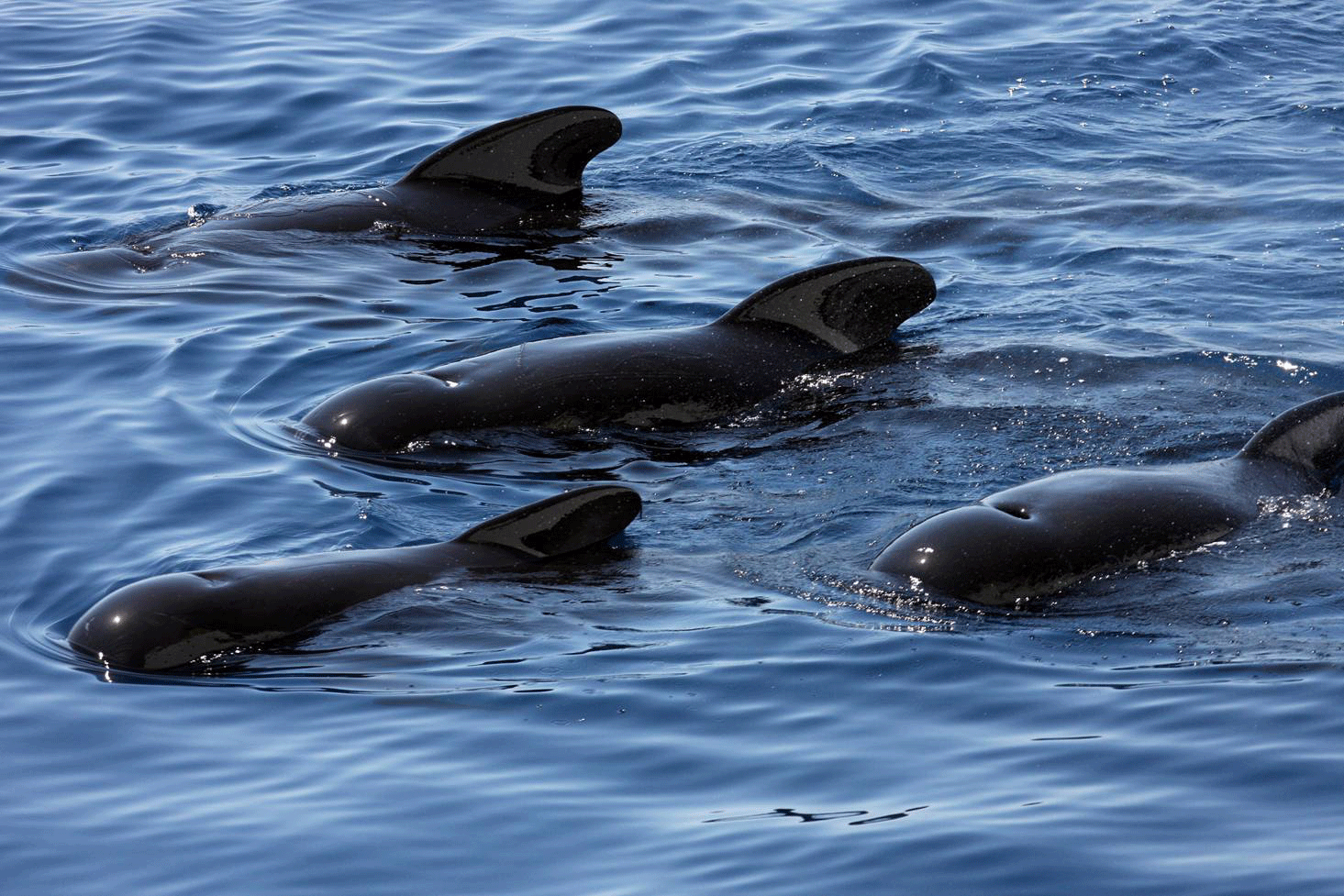
Long-finned pilot whales roam in large pods with hundreds of individuals and cluster in smaller groups like this one, photographed in the Alboran Sea (Western Mediterranean) during a WHOI research expedition in 2011. (Photo: Woods Hole Oceanographic Institution)
[SOUNDS OF VESSEL GETTING CLOSER, PASSING AND MOVING AWAY]
JENSEN: So as you can hear this is quite an increase in noise levels and in noise that actually stretches quite far up into echolocation frequencies. So this can be pretty important for the animals.
JERRETT: Jensen says that a noise like that could interfere with a dolphin’s ability to communicate, to find food or to avoid predators. There's a growing body of evidence that noise affects both the behavior and the physiology of dolphins. Much of the work that’s been done in marine bioacoustics has focused on these animals. As Aran Mooney says…
MOONEY: They're sorta the laboratory mouse of the marine mammal world.
JERRETT: What's new is what scientists are learning about the role of sound for other, more unusual, sea creatures, like the squid. Back around 2008, Aran Mooney made a discovery. Not only do squid detect sound, but they do so in a pretty wild way.
MOONEY: The best way to kinda think about how squid detect sound is to kinda think about fruit in Jell-O.
JERRETT: You heard that right; fruit, in Jell-O.
MOONEY: So sort of that Midwest delicacy where you kinda make your salad with the fruit in the Jell-O. The squid being the fruit and the Jell-O being the water column. And how squid detect sound is that essentially the sound wave literally vibrates them or moves them back and forth.
JERRETT: So, squid can feel themselves getting physically jostled by the sound wave. Essentially, they hear with their whole bodies. But squid aren't necessarily using sound to talk to each other. Instead, they might be using sound in some unexpected ways.
It’s a really new idea, but Mooney is beginning to think that young squid along with other larval invertebrates might use sound to navigate – that they cue in to the ambient sounds around suitable habitats, sounds made by waves, snapping shrimp or other animals that are common in those habitats.
[(SOUNDS OF SNAPPING SHRIMP AND DACYLLUS]
And Mooney’s latest research suggests that adult squid might rely on sound for different information – to alert them that predators are nearby.
MOONEY: The thing about working with squid is that there’s a range of responses. They can ink, they can change color and they can jet, meaning that they can swim away really fast and when we play a really abrupt predator type sound they do all three: they ink in the water, they swim away really fast and they’re doing color changes at the same time.
JERRETT: Is this something that has surprised you?
MOONEY: It’s definitely sort of surprising I feel like to a lot of the marine community. The fact that maybe we’re seeing some differences in adults and young is pretty neat. And, um, the fact that there's a key way that these guys are interacting with their environment and other animals that we didn't know about, that's pretty awesome. Pretty astounding.
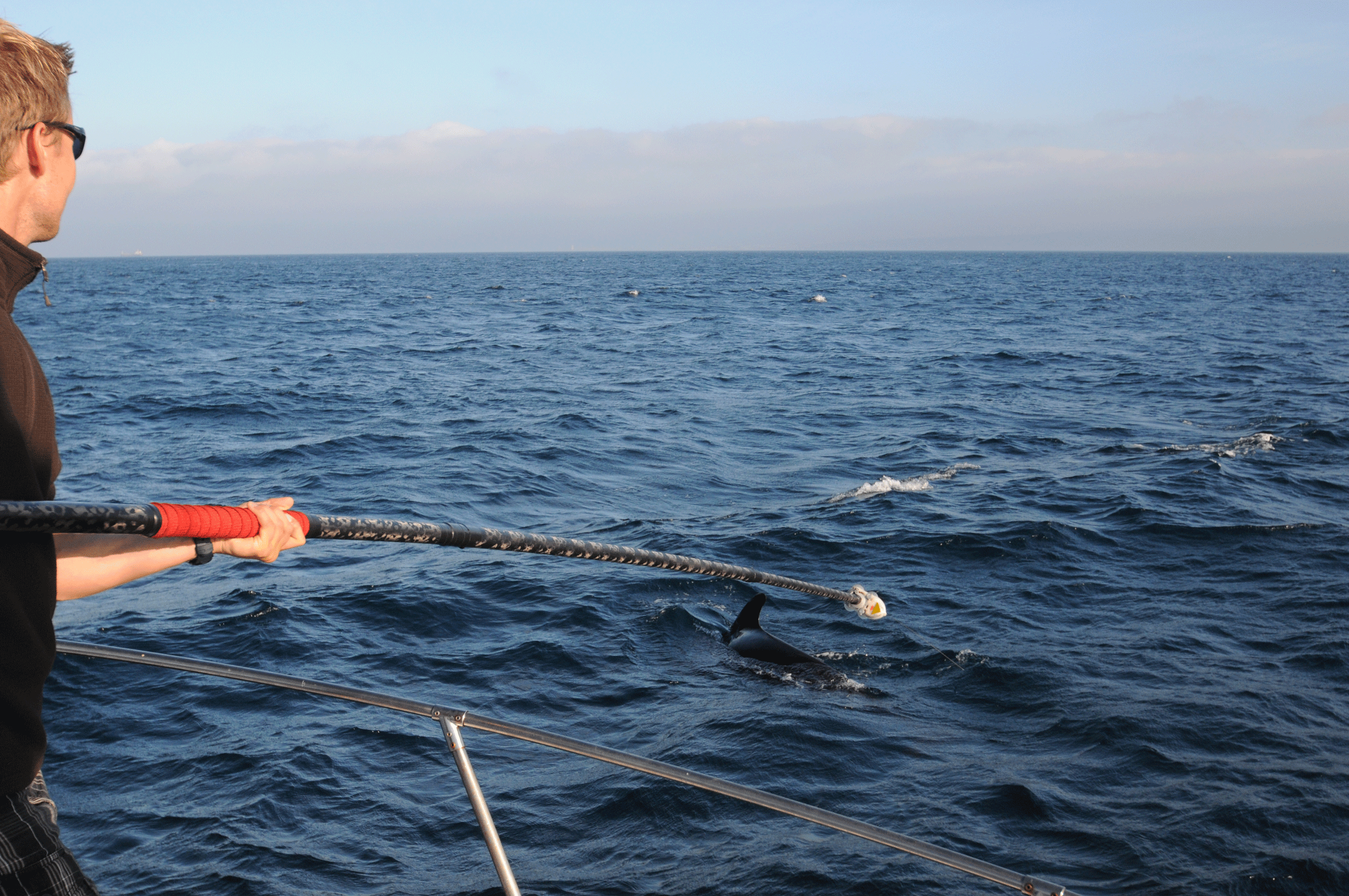
Frants Jensen tagging pilot whales in the Strait of Gibraltar. This research was performed under NMFS Marine Mammal Permit number 14241. (Woods Hole Oceanographic Institution)
JERRETT: Mooney doesn't know yet whether squid are affected by human created noise. That's one of his next projects. And he's looking at the relationship between sound and human activity in the ocean in other ways, too. His team is putting recorders in the ocean to monitor acoustics at the site of America's first proposed offshore wind farm -- in Nantucket Sound. They’re listening for what’s out there; both before and after the wind turbines go in.
[QUIET AMBIENCE OF NANTUCKET SOUND]
MOONEY: We want to know how those different patterns change; how often does the animal habitat use of the area change or how does the human habitat use change. It’s actually kind of an interesting place 'cause it’s relatively quiet. So um it might be a really great place to put a wind farm. We don’t know quite what to think about it yet.
JERRETT: Incorporating sound monitoring into offshore environmental planning is a pretty new approach. It's another way science can help people understand what's at stake with increasing human activity in the ocean. To start asking questions about what we should and shouldn't do. Frants Jensen puts it this way.
JENSEN: From a policy perspective, I think it's very important to strike a balance between being conservative and commercial development and we need to listen to what we can actually say with our data. Of course, there's going to be some impacts if you're putting out a water turbine or a wind turbine during offshore construction. What we really need to find out as researchers is how big those impacts are and whether, for that sake, they're worth the cost.
JERRETT: As humans put more pressure on ocean habitats and the creatures that live there, bioacoustics and the role of sound will have more to tell us. For now, Jensen and Mooney plan to keep listening.
In Woods Hole Massachusetts, I'm Jennifer Jerrett.
[MUSIC: Sound In The Sea: Regina Carter “Miner’s Child” from Southern Comfort (Sony Music 2014)]
CURWOOD: Next time on Living on Earth, with parts of the Pacific Ocean unusually warm, scientists say an El Niño is likely...
TRENBERTH: When an el Niño happens, because of climate change, the floods and the droughts in different places around the world tend to be stronger than they otherwise would be.
CURWOOD: Just where we can expect those floods and droughts...that's next time on Living on Earth.
CURWOOD: Living on Earth is produced by the World Media Foundation. Naomi Arenberg, Clairissa Baker, Bobby Bascomb, Emmett Fitzgerald, Helen Palmer, Catalina Pire-Schmidt, Adelaide Chen, James Curwood, and Jennifer Marquis all help to make our show.
Jeff Turton is our technical director. Special thanks this week to the C Image consortium for support of David Levin’s work. Alison Lirish Dean composed our themes. You can find us anytime at LOE.org, and like us on our Facebook page - it’s PRI’s Living on Earth. And we tweet from @LivingOnEarth. I'm Steve Curwood. Thanks for listening.
ANNOUNCER: Funding for Living on Earth comes from the Grantham Foundation for the protection of the environment. Supporting strategic communications and collaboration in solving the world’s most pressing environmental problems. The Kendeda Fund, furthering the values that contribute to a healthy planet, and Gilman Ordway for coverage of conservation and environmental change. Living on Earth is also supported by a friend of Red Tomato, supplier of righteous fruits and vegetables from northeast family farms. www.redtomato.org. This is PRI, Public Radio International.
ANNOUNCER 2: PRI, Public Radio International.
Living on Earth wants to hear from you!
Living on Earth
62 Calef Highway, Suite 212
Lee, NH 03861
Telephone: 617-287-4121
E-mail: comments@loe.org
Newsletter [Click here]
Donate to Living on Earth!
Living on Earth is an independent media program and relies entirely on contributions from listeners and institutions supporting public service. Please donate now to preserve an independent environmental voice.
NewsletterLiving on Earth offers a weekly delivery of the show's rundown to your mailbox. Sign up for our newsletter today!
 Sailors For The Sea: Be the change you want to sea.
Sailors For The Sea: Be the change you want to sea.
 The Grantham Foundation for the Protection of the Environment: Committed to protecting and improving the health of the global environment.
The Grantham Foundation for the Protection of the Environment: Committed to protecting and improving the health of the global environment.
 Contribute to Living on Earth and receive, as our gift to you, an archival print of one of Mark Seth Lender's extraordinary wildlife photographs. Follow the link to see Mark's current collection of photographs.
Contribute to Living on Earth and receive, as our gift to you, an archival print of one of Mark Seth Lender's extraordinary wildlife photographs. Follow the link to see Mark's current collection of photographs.
 Buy a signed copy of Mark Seth Lender's book Smeagull the Seagull & support Living on Earth
Buy a signed copy of Mark Seth Lender's book Smeagull the Seagull & support Living on Earth

